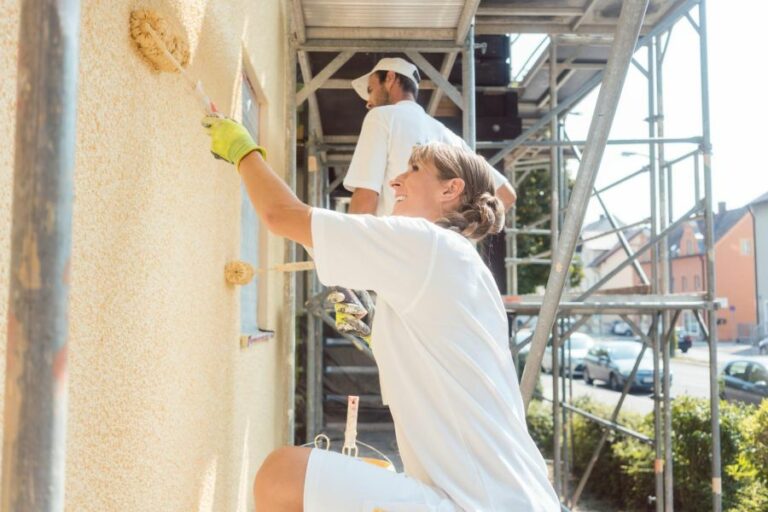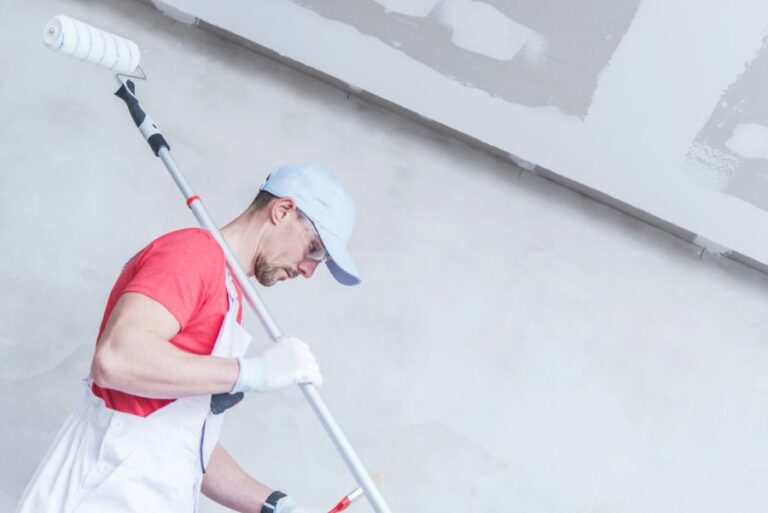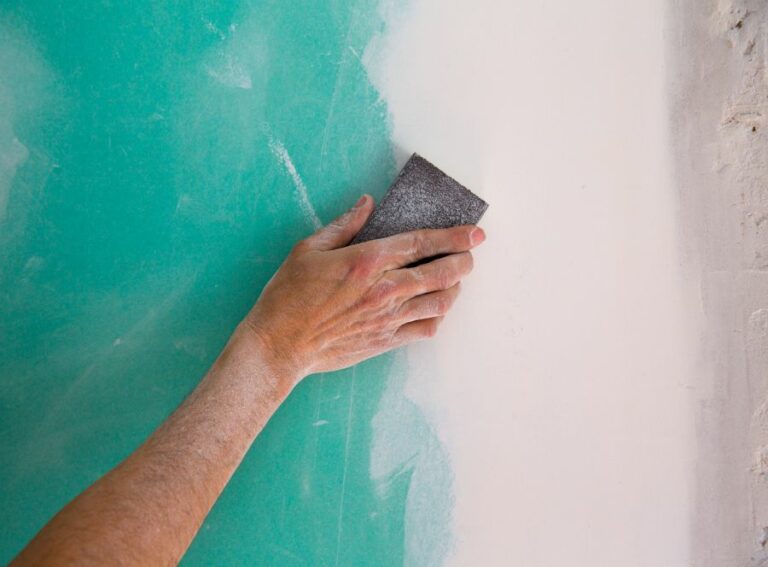Top Sanding Tips For Paint Perfection. What Pros Say
Are you tired of uneven paint finishes and desperately seeking that perfect look? We’ve got you covered! Our top sanding tips will help you achieve paint perfection in no time. With years of experience, we’re here to share our knowledge and expertise with you so you can finally have that flawless paint finish you’ve been aiming for.
Top sanding tips for paint perfection:
For paint perfection, follow these top sanding tips: understand the importance of sanding, choose the right sandpaper grit, invest in a quality sanding block, use power sanders cautiously, keep sandpaper clean, employ the proper sanding technique, wipe the surface after sanding, follow safety precautions, and know when to stop sanding. Practice and patience are essential for mastering the art of sanding.

Unleash your inner artist and achieve paint perfection with our top sanding tips. Discover expert techniques, proper tools, and the ideal timeline for a smooth, flawless finish. There’s more to uncover, so read on and perfect your paint job in no time!
Contents
- 1 Expert Sanding Techniques for Flawless Painting Results
- 1.1 • Understand the Importance of Sanding
- 1.2 • Choose the Right Sandpaper Grit
- 1.3 • Invest in a Quality Sanding Block
- 1.4 • Know When to Use Power Sanders
- 1.5 • Keep Your Sandpaper Clean
- 1.6 • Follow a Proper Sanding Technique
- 1.7 • Wipe Down the Surface After Sanding
- 1.8 • Follow Proper Safety Precautions
- 1.9 • Know When to Stop Sanding
- 2 Techniques to Sand Away Paint Blemishes
- 3 Key Sanding Strategies Prior to Painting
- 4 Mastering the Art of Smooth Paint Finishes
- 5 Selecting the Ideal Sandpaper for Paint Rectification
- 6 Perfect Grit Sandpaper to Eliminate Orange Peel
- 7 Choosing the Right Sandpaper Grit for Paint Preparation
Expert Sanding Techniques for Flawless Painting Results
• Understand the Importance of Sanding
Sanding is an essential step in the painting process, as it helps to create a smooth surface for the paint to adhere to. Failing to adequately sand a surface can result in an uneven, rough paint job. By investing time and effort in the sanding process, you can achieve long-lasting paint perfection.
• Choose the Right Sandpaper Grit
Selecting the appropriate sandpaper grit is crucial for achieving a smooth finish. Sandpaper grit is measured in grit numbers, with higher numbers indicating finer sandpaper. Here are some general guidelines for choosing the right sandpaper grit for your project:
- For rough, unfinished surfaces: 60-80 grit
- For surfaces with paint or varnish: 100-150 grit
- For smoothing surfaces between coats: 220-320 grit
In most cases, it’s best to start with a coarser grit and work your way to finer grits, removing any scratches or imperfections left by the previous grit.
• Invest in a Quality Sanding Block
Using a sanding block is highly recommended for achieving a consistent, even surface. A sanding block is a tool that holds sandpaper and provides a flat, hard surface to help ensure uniform pressure is applied when sanding. They come in various sizes and can be made of materials like rubber or cork.
• Know When to Use Power Sanders
Power sanders, such as orbital and belt sanders, can significantly speed up the sanding process, making them suitable for large projects or rough surfaces that require a lot of material removal.
However, these tools should be used with caution, as they can quickly remove too much material if not used correctly. For smaller or more delicate projects, hand sanding is often the better choice.
• Keep Your Sandpaper Clean
As you sand, dust and debris can accumulate on the sandpaper, reducing its effectiveness. To maintain the sandpaper’s efficiency, regularly clean it using a soft brush or tapping it against a hard surface. Additionally, consider using sandpaper with an open-coat design, as it is less susceptible to clogging.
• Follow a Proper Sanding Technique
A consistent, even sanding technique is crucial for achieving a smooth surface. Here are some tips to help improve your sanding technique:
- Sand in the direction of the grain: This helps to minimize scratches and ensures a smoother finish.
- Keep the sandpaper flat: This helps to apply consistent pressure and avoid digging into the surface.
- Do not press too hard: Applying excessive pressure can lead to scratches and uneven surfaces. Let the sandpaper do the work, applying only light pressure.
- Sand evenly: Spend an equal amount of time sanding all areas of the surface to achieve a uniform finish.
• Wipe Down the Surface After Sanding
After each round of sanding, it’s essential to wipe down the surface to remove any dust and debris left behind by the sandpaper. This can be done using a tack cloth or a damp, lint-free cloth. Cleaning the surface ensures that your subsequent coats of paint or varnish will adhere correctly.
• Follow Proper Safety Precautions
Sanding produces a significant amount of dust, which can be harmful to your lungs and skin. When sanding, be sure to wear eye protection, a dust mask, and gloves to protect yourself. Additionally, work in a well-ventilated area and consider using a shop vacuum to keep the workspace as clean as possible.
• Know When to Stop Sanding
Knowing when to stop sanding is just as important as knowing how to sand correctly. Over-sanding can lead to an uneven surface, especially when using power sanders. Be sure to sand just enough to remove imperfections and create a smooth surface for your paint or finish.
In conclusion, by following these top sanding tips, you can effectively prepare any surface for a flawless paint job. Remember, the key to paint perfection lies in proper sanding, and with practice and patience, anyone can master the art of sanding.
Tip no. | Tip |
|---|---|
1 | Choose the correct sandpaper grit for the task. |
2 | Sand in the direction of the wood grain to avoid scratches. |
3 | Use a sanding block or power sander for even pressure and coverage. |
4 | Start with a coarser grit and work your way to finer grits for a smooth finish. |
5 | Always clean the surface thoroughly between sanding stages to remove debris. |
6 | Use a tack cloth or vacuum to remove fine dust from the surface before painting. |
7 | Apply primer to fill imperfections and provide a smooth base for paint. |
Techniques to Sand Away Paint Blemishes
Paint imperfections come in various forms, and before you can embark on sanding them down, it is important to identify the specific type you are dealing with in order to take the best course of action. Common paint imperfections include:
- Orange peel: This textured appearance resembles the skin of an orange, typically caused by an uneven paint layer during application.
- Runs and sags: These occur when the paint is applied too heavily, causing the excess to drip or sag.
- Fish eyes: Small circular craters or depressions on the paint surface caused by contaminants such as oil or silicone.
- Dust nibs: Tiny, raised particles on the surface that are the result of debris settling onto the wet paint.
• Gathering Appropriate Tools and Materials
To effectively sand down paint imperfections, you will need:
- A range of sandpaper grits (specifically, 1000-grit, 1500-grit, and 2000-grit)
- A sanding block or pad (either rigid or flexible)
- Water and a spray bottle (for wet sanding)
- Clean, lint-free cloths
- Rubbing compound
- Polishing compound
- A dual-action polisher or a quality foam polishing pad
- Protective gear (gloves and safety goggles)
• Preparing the Surface for Sanding
Before you begin sanding down any imperfections, it is important to properly prepare the surface to ensure optimal results.
- Thoroughly clean the area: Before sanding, wash the surface with warm water and mild soap to remove any dirt, debris, or waxes, then wipe it dry with a clean cloth. Removing contaminants will prevent them from causing further issues during the sanding process.
- Choose the appropriate sandpaper grit: Start with the least aggressive sandpaper grit in order to minimize the loss of paint. For most imperfections, 1000-grit sandpaper is sufficient. However, if the imperfection is particularly deep or severe, it may be necessary to use a coarser grit, such as 800-grit, before progressing to finer grits.
- Prepare the sandpaper: To avoid scratching or damaging the surface, soak the sandpaper in water for at least 15 minutes before use. This will soften the paper and prevent the grit from dislodging during sanding.
• Wet Sanding Technique for Removing Imperfections
Wet sanding is an effective method for smoothing out paint imperfections while reducing the risk of damaging the surrounding paint.
- Attach sandpaper to the sanding block: Secure a piece of the 1000-grit sandpaper to your sanding block or pad. The block should be firm but will conform to the contours of the surface as you sand.
- Apply water to the surface: Spray the area with water from a spray bottle, ensuring it is thoroughly wet. This helps to create a smooth and even finish.
- Begin sanding: Sand the imperfection gently in a linear motion, using even pressure. Avoid sanding in circular patterns, as this can cause swirl marks. Continually spray water onto the surface to keep it lubricated and to help the sanding process.
- Assess the surface: After a few passes, wipe the surface with a clean, lint-free cloth and inspect the progress. If the imperfection is still visible, continue sanding with the 1000-grit sandpaper. Repeat this process until the imperfection is no longer visible or there is minimal orange peel texture.
- Move to finer grits: Once the imperfection has been minimized, move on to the 1500-grit sandpaper, followed by the 2000-grit sandpaper. This will help to restore the surface’s gloss and smoothness. Do not forget to pre-soak each sandpaper grit in water before use.
• Polishing and Buffing the Surface
After sanding, restore the surface’s shine and protect the paint by applying a rubbing compound, followed by a polishing compound.
- Apply rubbing compound: Using a dual-action polisher or foam polishing pad, apply a small amount of rubbing compound to the surface. Work the compound into the area using steady, even pressure and overlapping passes to blend the surrounding paint.
- Buff the surface: Once the section has been buffed with the compound, remove any residue with a clean, lint-free cloth. Buff the surface in a linear motion to avoid creating swirl marks.
- Apply polishing compound: After the surface has been buffed with the rubbing compound, apply a polishing compound in the same manner, using a fresh polishing pad or cloth. The polishing compound will help to restore the clear coat and give the paint a deep, shining appearance.
- Inspect the surface: Thoroughly check the surface to ensure that it is smooth and the imperfection has been removed. If necessary, repeat the polishing process for optimal results.
By following these steps, you can effectively sand down paint imperfections and restore a smooth, high-gloss finish to your vehicle’s surface.
Step | Description |
|---|---|
1. Gather materials | Prepare the necessary materials such as sandpaper (ranging from 1000- to 3000-grit), a sanding block, clean cloth, water, and paint polishing compound. |
2. Clean the surface | Before sanding, clean the surface to remove dirt or other contaminants that may cause further imperfections or hinder the sanding process. |
3. Wet the sandpaper | Prepare the sandpaper by soaking it in water to help reduce friction and prevent the paint from being scratched. |
4. Begin with a higher grit sandpaper | Start with a higher grit sandpaper, such as 1000- or 1500-grit, to gently remove rough spots and minor blemishes without damaging the paint around them. |
5. Sand in circular motions | Using a sanding block, gently rub the sandpaper in circular motions on the imperfections. Apply light pressure and consistently move around the area to avoid creating more damage. |
6. Continue with finer grits | As the imperfections become less noticeable, switch to finer grits, such as 2000- to 3000-grit, to further smooth the surface and prepare it for polishing. |
7. Clean the surface again | After sanding, use a clean cloth to wipe away any residue, and spray the surface with water to remove any remaining particles. |
8. Apply paint polishing compound | Lastly, apply paint polishing compound and use a clean cloth or polishing pad to restore the paint’s shine. |
Key Sanding Strategies Prior to Painting
Sanding before painting is a crucial step to ensure a smooth, professional finish on any surface.
• Understanding the Importance of Sanding
Sanding before painting is vital for several reasons:
- Remove imperfections: Sanding removes rough spots or slight imperfections on the surface, resulting in a smoother finish after painting.
- Promote adhesion: Sanding creates small grooves or scratches on the surface, increasing the paint’s ability to bond with the material.
- Smooth out layers: Sometimes, the previous paint or primer may have created an uneven texture. Sanding can help smooth out those layers, creating a more even surface.
• Choosing the Right Sandpaper
Selecting the right sandpaper for your project is essential for a successful sanding process. Sandpaper is categorized by grit, which refers to the coarseness of the abrasive material. Lower grit numbers are more coarse, while higher numbers are finer.
Here are some general guidelines for choosing sandpaper grit before painting:
- 40-60 grit: Used for heavy-duty sanding or removing multiple layers of paint (use with caution to avoid damaging the surface)
- 80-120 grit: Ideal for removing small imperfections and preparing bare surfaces, such as wood or drywall, for painting
- 180-220 grit: Used for finer sanding or smoothing out surfaces between coats of paint
In general, it’s best to start with medium grit sandpaper and gradually work your way up to a finer grit as needed.
• Proper Sanding Techniques
Follow these expert tips to ensure a consistent, even surface during the sanding process:
– Use a Sanding Block
Using a sanding block is highly recommended for maintaining even pressure and keeping the surface level. A sanding block can be purchased or improvised by wrapping sandpaper around a flat, firm object.
– Sand in the Direction of the Grain
When working with wood surfaces, always sand in the direction of the wood grain. This helps prevent scratches and ensures smoother results.
– Apply Even Pressure
Maintain consistent pressure while sanding to avoid creating uneven spots on the surface. Applying too much pressure can cause scratches or remove more material than desired.
– Use a Tack Cloth
A tack cloth is a sticky cloth designed to remove dust and debris from the surface after sanding. Using a tack cloth between sanding stages and before painting ensures that your surface remains clean and dust-free.
– Sand Between Coats
For the best results, sand between coats of paint or primer. This process, known as “scuff sanding,” creates a roughened surface for the next coat to adhere properly. Use lighter grit sandpaper, such as 180-220 grit, to avoid damaging the underlying coat of paint.
• Ensuring a Dust-Free Environment
An essential factor to remember when sanding before painting is maintaining a clean environment. Dust and debris can create uneven or unintended textures in your paint job. Here are some tips for maintaining a dust-free work area:
- Vacuum: Use a vacuum with a dust attachment to remove particles from your work area.
- Air filtration: Use an air filtration system to help maintain a clean environment for painting.
- Wipe surfaces: Wipe down surfaces with a damp cloth to eliminate dust particles.
- Paint in a well-ventilated area: Proper ventilation reduces airborne particles and prevents them from settling on freshly painted surfaces.
• Safety Precautions
When working with sanding and painting, always consider the following safety precautions:
- Wear protective gear: Use safety glasses, gloves, and a dust mask. Prolonged exposure to dust can cause respiratory irritation.
- Work in a well-ventilated area: Ensure your work area is well-ventilated to reduce dust accumulation and paint fume inhalation.
- Dispose of dust and debris properly: Properly discard sanding debris to reduce the risk of potential hazards, such as fire.
By following these tips and techniques for sanding before painting, you’ll guarantee a smooth, professional finish in all your DIY projects.
Mastering the Art of Smooth Paint Finishes
Achieving a perfectly smooth paint finish may seem like a daunting task, but with the right techniques and tools, it is possible.
• Preparing the Surfaces for Smooth Painting
Before you start painting, it is essential to prepare the surface thoroughly.
– Cleaning the Surfaces
First, clean the surface to remove any dirt, dust, or grease. Use a mild detergent and water to clean metal and plastic surfaces or a gentle wood cleaner for wooden surfaces.
– Sanding for a Smooth Base
To achieve a flawless finish, it’s crucial to sand the surface, especially if there are any existing paint or imperfections. I recommend using fine-grit sandpaper (180-220 grit) and sanding with the grain.
This helps in creating a smooth base for new paint. After sanding, use a tack cloth to remove any dust particles.
– Priming the Surfaces
Priming is an essential step in preparing surfaces for smooth painting. A quality primer will help seal and even out the surface, providing a base for better paint adhesion.
Opt for a water-based primer for most surfaces, or use an oil-based primer for areas prone to high levels of moisture, like bathrooms and kitchens. Allow the primer to dry according to the manufacturer’s instructions.
• Selecting the Right Paint and Brushes for Smooth Painting
The type of paint and brushes you choose can significantly impact the final results.
– Choosing the Right Paint
For a smoother, more self-leveling finish, opt for water-based latex paint in a satin or semi-gloss finish. These types of paint tend to level out as they dry, reducing the visibility of brush strokes. High-quality paints also have better leveling properties and offer better coverage.
– Selecting the Right Brushes
Investing in high-quality paintbrushes will help you achieve a smoother paint finish. Look for brushes with synthetic bristles, such as nylon or polyester. Tapered bristles provide better control and help in reducing visible brush strokes.
• Mastering the Techniques for a Smooth Paint Finish
Once you have prepared the surface and selected the right paint and brushes, it’s time to focus on proper painting techniques.
– Loading the Brush for Smooth Coverage
Dip the brush into the paint until just the lower third of the bristles is submerged, then gently tap the brush against the paint container’s side to remove any excess paint. This helps in applying a consistent amount of paint to the surface.
– Rolling the Paint for an Even Result
For large, flat surfaces, using a paint roller can help achieve a smoother finish. After loading the roller with paint, apply it to the surface in a “W” pattern. Then, roll back over the “W” with a straight up and down motion to fill in the gaps and ensure consistent coverage.
– Brushing for Smooth Results
For smaller or more detailed areas, using a brush is necessary. Maintain a wet edge by brushing back over the area you just painted, thus blending the new paint with the already applied paint. This helps to reduce visible brush strokes and provides a smoother finish.
– Properly Applying Thin Coats
Instead of applying one thick coat, aim for multiple thin coats of paint. Thinner coats result in a more even and smoother finish, as they allow the paint to level out as it dries. Make sure to allow the required drying time between each coat, as recommended by the paint manufacturer.
• Addressing Common Painting Problems
Even with the best preparation and technique, issues may arise during the painting process. Being aware of these common problems and their solutions can help in maintaining a smooth finish.
– Preventing Paint Sagging and Wrinkling
Paint sagging and wrinkling occur when the paint is applied too thickly. If you notice these issues, immediately use your brush to remove the excess paint and smooth out the area. To prevent this issue, remember to apply multiple thin coats, allowing for proper drying time between each coat.
– Fixing Visible Brush Strokes
If brush strokes remain visible after the paint has dried, you can sand the area lightly with fine-grit sandpaper (about 320-grit) to remove the imperfections. Wipe down the surface with a tack cloth and apply an additional thin coat of paint, ensuring to maintain a wet edge as you work.
– Cleaning Paint Drips and Splatters
Carefully remove dried paint drips with a scraper or fine-grit sandpaper. For fresh paint splatters, quickly clean them up with a damp cloth.
In conclusion, achieving a perfectly smooth paint finish requires careful attention to surface preparation, paint selection, painting techniques, and addressing any issues that may arise during the process.
By following these expert recommendations, you can create pristine, professional-quality results on your next painting project.
Step | Description |
|---|---|
1 | Choose the right paint and tools: Use high-quality paint and brushes or rollers for smoother results. |
2 | Prepare the surface: Clean and sand the surface to be painted, removing any dirt, dust, and debris. |
3 | Apply a primer: Applying a primer ensures better adhesion of paint and improves durability. |
4 | Use the proper painting technique: Use smooth, even strokes and work in a consistent direction with the grain of the surface. |
5 | Apply multiple thin coats: Applying thin layers of paint will produce a smoother finish, allowing adequate drying time between coats. |
6 | Sand between coats: Lightly sand between each coat of paint to ensure a perfectly smooth finish. |
7 | Finish with a topcoat: Apply a clear topcoat or varnish to protect the surface and give it a final smooth finish. |
Selecting the Ideal Sandpaper for Paint Rectification
Paint correction is a crucial step in automotive detailing to achieve a flawless finish on your car’s painted surface. It involves the removal of imperfections such as swirls, scratches, and oxidation. Selecting the right sandpaper is an essential part of the paint correction process.
• Types of Sandpaper
There are various types of sandpaper available for paint correction, each designed for specific purposes.
– Aluminum Oxide Sandpaper
Aluminum oxide sandpaper is an excellent choice for paint correction as it is a durable and long-lasting abrasive. Its durability ensures that the sandpaper does not wear out easily and can be used for an extended period.
This type of sandpaper works seamlessly on various surfaces, including metal, wood, and plastics.
– Silicon Carbide Sandpaper
Silicon Carbide sandpaper, commonly known as wet or dry sandpaper, is a suitable option for paint correction as it can be used both dry and wet. The waterproof ability allows it to withstand water, making it perfect when using a lubricant during wet sanding.
This sandpaper is ideal for removing scratches and orange peel effects on painted surfaces.
– Ceramic Sandpaper
Ceramic sandpaper offers a high-performance cutting experience, making it an ideal option for professionals. Its durability and heat resistance makes it suitable for heavy paint correction tasks.
• Grit Levels for Paint Correction
When choosing the right sandpaper for paint correction, it is essential to know about grit levels. It refers to the size and roughness of abrasive particles on the sandpaper.
A lower grit number means larger particles and a rougher surface, while a higher grit number signifies smaller particles and smoother finishes.
– 1000 to 1500 grit
Sandpapers with grit levels in the range of 1000 to 1500 are ideal for removing severe paint imperfections such as deep scratches and orange peel effects. These coarse sandpapers can strip a significant layer of paint from the surface.
However, using this level of grit should be done cautiously to avoid causing further damage.
– 2000 to 2500 grit
When dealing with intermediate to fine imperfections, such as light scratches and swirls, it is advisable to opt for sandpaper with grit levels between 2000 and 2500. This grit can effectively eliminate mild-to-moderate paint defects while ensuring a smoother finish.
– 3000 grit and above
For finessing and polishing, sandpapers with grit levels of 3000 and above are ideal. This level of grit is essential for refining the results of previous sanding stages and preparing the surface for final polishing or waxing.
• Techniques for Paint Correction
– Dry Sanding
Dry sanding is a technique that purely relies on using sandpaper without any lubrication. It is more aggressive and faster-acting than wet sanding, making it suitable for removing severe paint imperfections.
Dry sanding requires utmost caution to avoid creating further scratches or damaging the clear coat. It is also essential to wipe away the residue and dust before moving on to the next stage of paint correction.
– Wet Sanding
An advanced form of paint correction is wet sanding, requiring water or a lubricant. This technique helps to prevent excessive heat buildup and reduces the risk of damaging the paint surface. Wet sanding enables more precise control over the sanding process, resulting in a smoother finish.
It’s crucial to clean the surface thoroughly after each sanding stage and check for any remaining imperfections.
• Final Thoughts
Choosing the best sandpaper for paint correction depends on several factors. It is vital to consider the type of sandpaper, the grit level, and the technique suitable for addressing specific paint imperfections.
Always start with a less aggressive approach and slowly progress to ensure minimal damage to the paint surface.
Moreover, practice patience and precision throughout the process.
Brand | Type | Grit Range |
|---|---|---|
3M | Wetordry | 1000-3000 |
Norton | Ice | 1000-2500 |
Meguiar’s | Unigrit | 1500-3000 |
Mirka | Abralon | 180-4000 |
Perfect Grit Sandpaper to Eliminate Orange Peel
Orange peel is a common issue faced by car enthusiasts and professionals alike. It refers to the bumpy texture on the surface of a paint job that resembles the skin of an orange. This is often caused by improper painting techniques, poor quality paint, or other external factors.
To achieve a smooth, mirror-like finish on your vehicle, you need to remove the orange peel using the right grit sandpaper. In this article, we will discuss the different sandpaper grits and their effectiveness in removing orange peel.
• Understanding Sandpaper Grit
Sandpaper is categorized by the size of the abrasive particles or grit on its surface. The grit number represents the number of abrasive granules per square inch of sandpaper. The lower the grit number, the coarser the sandpaper and the more material it will remove from the surface.
When selecting the right sandpaper grit to remove orange peel, it’s essential to strike a balance between aggressive material removal and leaving minimal scratches behind. Let’s explore the most common grits used in the process of removing the orange peel.
– 1000 Grit Sandpaper
1000-grit sandpaper is considered to be the starting point for removing the orange peel. It is effective in leveling the surface and getting rid of the texture without causing any significant surface damage. However, using 1000-grit sandpaper may require more time and effort in comparison to coarser grits.
As a recommendation, 1000 grit sandpaper can be used on softer clear coats or single-stage paints, as these surfaces can be more easily damaged by coarser grits.
– 1200 Grit Sandpaper
1200-grit sandpaper is another popular option for removing the orange peel. It’s slightly less aggressive than 1000 grit sandpaper, so it may take a bit longer to remove the texture. However, it does provide a smoother surface, making it easier to polish afterward.
I recommend using 1200 grit sandpaper on harder or medium hardness clear coats, as it is less likely to cause harm compared to coarser grits.
– 1500 Grit Sandpaper
1500-grit sandpaper falls into the category of fine sandpaper. Its primary use is for refining the surface after removing the orange peel with a coarser grit. By using 1500-grit sandpaper, you can minimize the scratching left behind, making it easier to buff and polish the surface.
In some cases, where the orange peel is very mild, or the clear coat is particularly soft, you may be able to use 1500 grit sandpaper to gently remove the texture.
• The Sanding Process
When sanding the vehicle’s surface, it’s essential to use the appropriate technique to minimize the risk of damaging the paint.
Always wet sand the surface to provide lubrication and prevent excessive heat buildup. To further ensure an even and consistent finish, use a sanding block or foam pad during the process.
Start with the lowest-grit sandpaper recommended for your particular surface (either 1000 or 1200 grit). Sand the area with long, even strokes until the orange peel is no longer visible. Be cautious not to sand too deep, as this can damage the clear coat and cause burn-through.
Follow up with the 1500-grit sandpaper, refining the surface to minimize the scratches left behind by the previous grit. When satisfied with the results, move on to polishing and buffing to restore the shine to your vehicle’s paint.
• Final Thoughts
In conclusion, determining the proper grit sandpaper to remove orange peel depends on the severity of the texture and the hardness of the clear coat. Starting with either 1000 or 1200-grit sandpaper is generally recommended, followed by 1500-grit sandpaper to refine the surface.
Using the appropriate sandpaper grit and technique will help you achieve a smooth, mirror-like finish on your vehicle’s paint.
Choosing the Right Sandpaper Grit for Paint Preparation
Selecting the appropriate grit sandpaper for paint preparation is crucial to achieving a smooth, polished surface. The correct grit ensures that the paint adheres well to the surface, resulting in a durable, long-lasting finish.
Vide a detailed understanding of different grit sandpaper and their applications in paint preparation.
• Understanding Sandpaper Grits
Sandpaper is made by affixing abrasive particles to a paper backing. The coarseness of the sandpaper is termed as its ‘grit,’ and is measured by the number of abrasive granules per inch of the paper. Higher grit numbers indicate finer sandpaper that has a greater number of smaller particles.
– Coarse Grit (40-60) Sandpapers
Coarse grit sandpapers remove material quickly and are used for rough shaping or eliminating heavy stock. They are not typically employed for paint preparation, as the scratches left behind by these grits are too deep for painting purposes.
– Medium Grit (80-120) Sandpapers
Medium-grit sandpapers are used for smoothing surfaces and removing small imperfections. These grits are versatile and commonly employed for both wood and metal paint preparation. They are effective in removing old paint but may leave minor scratches that can affect paint adhesion.
– Fine Grit (150-180) Sandpapers
Fine-grit sandpapers provide a smoother finish than medium-grit sandpapers. They are ideal for final paint preparation as they remove minor scratches and blemishes, ensuring smooth paint application. Fine grit is the recommended starting point for most paint preparation tasks.
– Extra-Fine Grit (220-400) Sandpapers
Extra-fine grit sandpapers are used for precision tasks and the final stages of smoothing a surface. They are best suited for sanding between coats of paint or achieving an ultra-smooth finish on delicate materials.
• Choosing the Right Sandpaper Grit for Paint Preparation
– Paint Preparation on Wood Surfaces
- Begin with 120-grit sandpaper to remove old paint or varnish while preserving the wood’s integrity.
- Progress to a 150 or 180-grit sandpaper to create a smooth surface for the new paint to adhere to.
- If desired, use a 220-grit or higher sandpaper between coats of paint to achieve a very smooth finish.
– Paint Preparation on Metal Surfaces
- Use 120-grit sandpaper to remove any rust or peeling paint from the metal surface.
- Move on to 180-grit sandpaper to create a smooth surface for painting.
- Optionally, use 220-grit sandpaper between coats of paint for a smoother finish.
– Paint Preparation for Automotive Applications
- Start with 80-grit sandpaper to remove heavy scratches or significant paint imperfections.
- Move up to 180-grit sandpaper to create a smooth surface for primer application.
- After applying primer, gently sand using 320-grit sandpaper to ensure proper paint adhesion.
- Between coats of paint and clear coat applications, use a 400-grit or higher sandpaper to achieve a professional, ultra-smooth surface.
• Important Tips for Using Sandpaper in Paint Preparation
- Always sand in the direction of the wood grain or metal brushing to prevent cross-grain scratches that can negatively impact the finished result.
- Use a sanding block or pad for even pressure distribution to avoid creating uneven spots on the surface.
- Frequently inspect your sandpaper for wear and clogging. Replace the sheet when it loses its cutting ability.
- Employ a vacuum, brush, or tack cloth to thoroughly remove any dust or debris from the surface before painting. Residual dust and debris may compromise paint adhesion and overall finish quality.
By utilizing the appropriate sandpaper grit and following proper preparation techniques, you can create a well-prepared surface for painting that will result in a long-lasting, attractive finish.
Assess your paint preparation requirements and make informed decisions on the proper sandpaper grit for your application.







